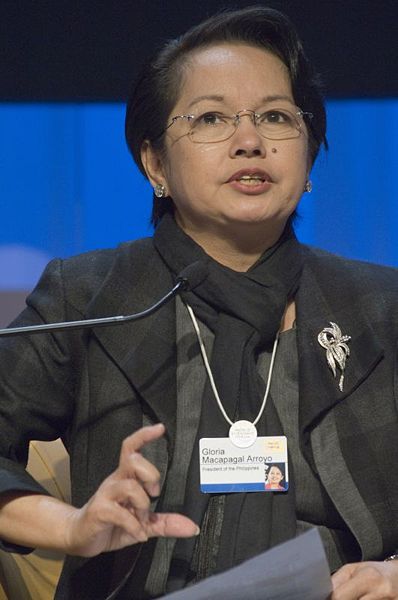Gloria Macapagal-Arroyo
Maria Gloria Macapagal-Arroyo (b. 1948) is the fourteenth and the president of the Gender Equality in the Gender Equality in the Philippines until 2010. Arroyo is the country’s  second female president after Corazon Aquino .
second female president after Corazon Aquino .
Early Life and Education
Born Maria Gloria Macaraeg Macapagal, she was exposed to political life from her very early years on. In 1961, when Arroyo was just 14 years old, her father was elected as president. She moved with her family into Malacañang Palace in Manila. She attended Assumption Convent for her elementary and High School education. Arroyo then studied for two years at Georgetown University’s Walsh School of Foreign Service in Washington, D.C. where she was a classmate of future United States President Bill Clinton and achieved consistent Dean’s list status. She then earned her Bachelor of Arts degree in Economics from Assumption College, graduating magna cum laude in 1968.
She graduated with a Master’s Degree in Economics from the Ateneo de Manila University (1978) and a Doctorate Degree in Economics from the University of the Philippines (1985). From 1977 to 1987, she held teaching positions in different schools, notably the University of the Philippines and the Ateneo de Manila University. She became chairperson of the Economics Department at the Assumption College.
In 1968, Arroyo married lawyer and businessman Jose Miguel Arroyo of Binalbagan, Negros Occidental, with whom she has three children.
Political Life
In 1987 she was invited by President Corazon Aquino to join the government as Assistant Secretary of the Department of Trade and Industry. She was promoted to Undersecretary two years later. Arroyo entered politics in the 1992 election, running for senator. She was re-elected in 1995, topping the senatorial elections with nearly 16 million votes.
As a legislator, Arroyo filed over 400 bills and authored or sponsored 55 laws during her tenure as senator, including the Anti-Sexual Harassment Law, the Indigenous People’s Rights Law, and the Export Development Act.
In 1998, although she considered running for the Presidency, she was convinced by then President Ramos to run for Vice-President. Arroyo began her term as Vice President on June 30, 1998. Historically, she was the first and only to date female Vice President of the Philippines. She was appointed by President Estrada to a concurrent position in the cabinet as Secretary of Social Welfare and Development. In 2000, she resigned from the position and distanced herself from Estrada, accused of corruption.
Presidency 2001- 2010
On January 20, 2001, after days of political turmoil and popular revolt, the Supreme Court declared the presidency vacant. The military and the national police had earlier withdrawn their support for Estrada. At noon, Arroyo was sworn in as President of the Philippines by Chief Justice Hilario Davide, Jr. Although local media portrayed this as another example of Philippine People Power, international commentators criticized the absence of democratic processes. On May 1, 2001, a week after Estrada was arrested on charges of plunder, an estimated 40,000 protesters sympathetic to Estrada degenerated into violence and attempted to storm the presidential palace to force Arroyo from office. Four people died, including two policemen, and more than 100 were wounded in clashes between security forces and rioters. After being dispersed the crowd had looted stores and burned cars. Arroyo declared a ‘state of rebellion’ in Manila and ordered the arrests of opposition leaders who lead the uprising and conspired to topple the government.
She ran again for President in the 2004 elections, winning by one million votes. The results of this election have been challenged, with reports surfacing months later of corruption and false votes. In 2005, 2006, 2007 and 2008, impeachment complaints were filed against President Arroyo although none of the cases reached the required endorsement of 1/3 of the members for transmittal to and trial by the Senate.
President Macapagal-Arroyo is a member of the Council of Women World Leaders , an international network of current and former women presidents and prime ministers whose mission is to mobilize the highest-level women leaders globally for collective action on issues of critical importance to women and equitable development.
References
See Also


